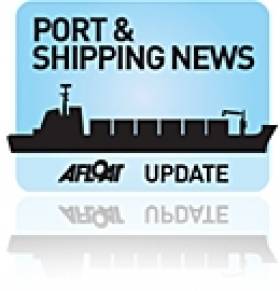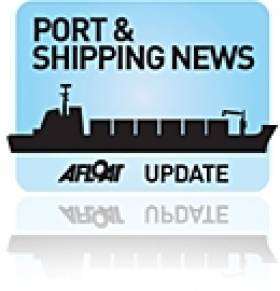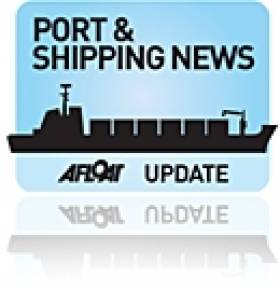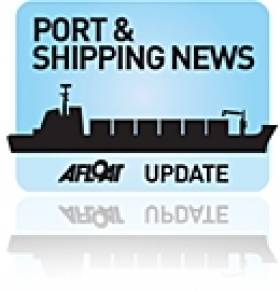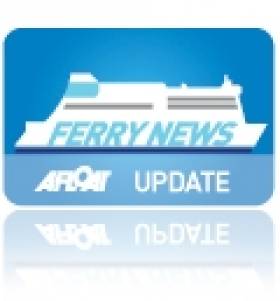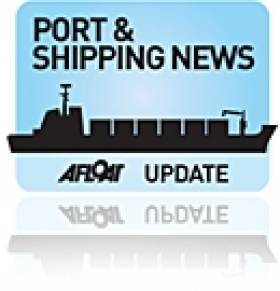Displaying items by tag: Ports & Shipping news
Fortnight to ShortSea 2013
#ShortSea13 – As previously reported, the European Shortsea Conference 2013 is to take place in a fortnights time on 14 March and for the first time held in France.
Shortsea 2013 will meet in Paris, where the event is organised by BP2S /SPC France, in cooperation with the ESN. Chairing the event will be Alfons Guinier, Secretary General, of the European Community Shipowners' Association.
Click HERE, for further details of the conference agenda, and how you can contribute to this event as a speaker, sponsorship opportunities and how to register as a a delegate.
Growth in Manufacturing Sector Accelerates
#News Update - Ireland's rate of growth in the manufacturing sector accelerated last month as businesses reported signs of strengthening demand.
The latest NCB Manufacturing Purchasing Managers' Index rose to 51.5 in February, up from 50.3 in January. A reading above 50 indicates expansion. Irish manufacturing activity has now expanded for 12 successive months.
A breakdown of the numbers showed new orders returned to growth in February, following a marginal reduction in January. For more on this The Irish Times has a report.
Again ‘Tank’ Goodness for Guinness
#GuinnessTanks – More than a week after cargoship Myrte docked in Dun Laoghaire Harbour, the massive fermentation tanks were yesterday transported in a nighttime convoy to the Guinness St. James's Gate Brewery in Dublin, writes Jehan Ashmore.
Another shipment is scheduled to arrive in the harbour towards the end of this weekend and also from Rotterdam. On this occasion, cargoship Keizersborg (1996/6,142grt) operated by Dutch owners Wagonborg Shipping, will be bringing in the second of three batches of the gleaming stainless steel cylinders.
Each of the 30 ton cylinders measure 22m long x 6.6m wide and 5.4m in height and some of them are capable of holding just under 1m pints!
As for the 122m long Myrte (2008/6,120grt) she took the honour as the first commercial vessel, excluding the fastcraft HSS Stena Explorer, to call to the harbour with a consignment of cargo, not seen since the early 1990's.
During that timeframe, the Danish flagged reefer Nordland Saga (1989/2,469grt), which then was a relative newbuild, had also berthed alongside Carlisle Pier.
The vessel registered in Frederickshavn differed to the 'Guinness' project cargo carrying vessels, in that she was fitted with deck-mounted cranes. As such mobile road cranes will again be deployed in the task of unloading the giant tanks onto the Carlisle Pier, where in recent years the former mailboat ferry terminal was demolished.
Carlisle Pier to date has served at times as storage space for yachts and currently has car-parking facilities, yet there are plans to build a landmark Diaspora Centre as part of the harbour's 'master plan'.
Cattle Ship ‘Express 1’ Reaches Libyan Port
#CattleShip – The recently renamed livestock-carrier Express 1 arrived today at the Libyan port of Misrata, having taken a 9 day voyage from Waterford, writes Jehan Ashmore.
As reported yesterday, the 7,087 tonnes vessel had been renamed while berthed in Waterford (Belview) port, having arrived as Al Mahmoud Express from the Mediterranean.
When loading the 2,900 cattle in Belview Terminal, they had arrived in trucks and were then transferred via a gangway and through the vessel's side loading door.
The trucks could not be driven on board via the former vehicle-carrier (built as the Autoline) which since conversion for the cattle trade, no longer has stern loading doors and outstretching ramp to quayside capability.
IMDO Shipping Review: Weak Global Container Demand, Reduced Rotterdam Shipping and Increased German Shipping Funds
#SHIPPING -The latest Weekly Shipping Market Review from the Irish Marine Development Office (IMDO) reports of the weak global demand in container volumes in the world's top 25 ports.
The number of ships calling to Rotterdam have decreased further in 2012 where there were fewer ferry service departures, reducing the number of arrivals by 2,347 to 32,057 ship visits.
German shipping funds sold three times as many ships in 2012 as in the previous year, according to figures released by Deutsche Fonds Research (DFR). 86 vessels were disposed of last year, in comparison to only 25 in 2011.
The complete Shipping Markets Review for week 8 is available as a PDF to read or download HERE.
Cattle Ship for Libya Under Different Name and Bound for Misrata
#CATTLE-SHIP -It transpires the livestock-carrier which departed Waterford port just over a week ago is under a different name and is bound for Misrata, and not the Libyan capital Tripoli as reported, writes Jehan Ashmore.
The livestock-carrier's previous name was Al Mahmoud Express (1983/7,087grt) but is now the Express 1, which has revived the live cattle trade, not seen since 1996, when Libya banned beef imports from the EU, following the outbreak of (BSE) mad cow disease.
The Panamanian flagged vessel with 2,900 cattle, is in the Mediterranean Sea between Tunisia and Malta and the passage time from Ireland to Libya is estimated to take up to 10 days.
During the vessels near 48 hour call to Belview, the port of Waterford, animal welfare groups had expressed concerns of the resumption in the trade carried out at the downriver terminal in which they tried to access.
The vessel is no stranger to Irish waters having operated as the custom built vehicle-carrier Autoline.
Countdown to P&O Express Scottish Service
#P&OExpress – A month to go sees the return of P&O Ferries fastcraft 'Express' service on the two-hour Larne-Troon route, which operates from 27 March to October.
The P&O Express (1998/5,902grt) accommodates more than 800 passengers and nearly 200 vehicles on the short hop across the North Channel linking Antrim and Ayrshire. The fastcraft also operates on certain sailings in tandem with ro-pax ferries running on the Larne-Cairnryan route.
On board facilities include a Fables Restaurant, the Harbour Coffee Company and for shoppers at sea, a stroll around the spacious Seashop.
Like other Irish Sea fast-ferries during the winter months, these vessels would go into 'hibernation' mode. As for the Austal built Express 91m craft completed in Fremantle, she spent several months lying in Belfast Harbour.
For further details of the P&O Express service on the Larne-Troon service click HERE.
#NewMaritimeMuseum – As previously reported, Shannon Foynes Port Company's master plan 'Vision 2041' looks forward to the future and soon the past will be explored when a new maritime museum opens next month, writes Jehan Ashmore.
It was at the launch of the masterplan at the Foynes Flying Boat Maritime Museum, where the new museum (opening 14 March) will be incorporated, to trace the rich history of the Shannon Estuary.
As the largest 'navigable' estuary (500km2) in Ireland and one of the deepest waterways in Europe, the museum will not just focus on shipping, but also the geology, personality and mythology of the estuary stretching from Limerick Docks down to Loop Head, marking the mouth of Shannon.
As previously reported, vessels such as the 82,562dwt London 2012, a dry bulk-carrier (Length: 229m X Beam: 32m X Draft: 14m) had docked at the Aughinish Alumina jetty last month.The port, which is Ireland largest bulk port company can handle larger vessels up to 200,000dwt, however under Vision 2041, the Shannon estuary is to cater for the World's largest container ships as the port is strategically located as a potential hub-port in Western Europe and creation of a 'Ocean Energy Hub'.
Its prime position is to take advantage of the new 'post-Panamax' sized super container ships and tankers under construction following the completion of the enlarged Central American canal linking the huge Asian market, notably from China and or via North America and onwards to Europe.
As these developments look to the future prospects of the estuary's ports, the past will not be forgotten as the flying boat museum with its replica aircraft based in Foynes, will have a new floor dedicated to exhibits. The diversity of topics on display in the maritime museum are listed below.
• The charts and maps of the river from the time of Ptolemy.
• The geology, tides and weather of the Shannon
• The pilots who raced in their rowing boats to be the first to guide large sailing ships up the estuary
• The dockworkers loading and unloading a vast range of cargo from ocean-going ships
• The "Spring-Rice Set" —the O'Briens, De Veres and Spring Rices, who owned large tracts of land on the shores of the river but who were actively concerned in the welfare of the less fortunate people around them
• The amazing record of ships on the river left to us by Murrogh O'Brien in the form of paintings and charts
• Different types of ships and boats used on the river
• The development of Foynes Port
• Navigation of the river including the many lighthouses that guided mariners up the river
• The tragic story of the Colleen Bawn
• The story of Transportation and emigration on the river.
• Tait's manufacture and export of uniforms to the American confederates during the Civil War.
• Display with Met Maps and audio visual on weather conditions.
• Story of the Windsor Castle Ghost Ship, sailed up the Shannon in 1843.
• Audio Visual on life on the River Shannon.
The maritime museum will be opened to the public from 14 March, 9am-5pm (visitors should try and arrive an hour before closing). For further details visit: www.flyingboatmuseum.com/
Ports & Shipping Review: Ferry Takes a Battering, Busy Port, Aircraft-Carrier’s Valentine Call, Tanks for Guinness, Cattleship for Libya and much more …
#P&SReview – Over the last fortnight, Jehan Ashmore has reported from the shipping scene, where at Dover, P&O Ferries protested to the Office of Fair Trading over Eurotunnel's bid to manage Calais and Boulogne ports.
The Marine Institute's RV Celtic Explorer called to Dublin Port in between scientific surveys, one in which included a Methane-derived Authigenic Carbonate (MDAC) survey some 25 nautical miles offshore of Dublin Bay.
As a snapshot of Drogheda Port's shipping scene, nine cargoships called within 48 hours, demonstrating the busy Co. Louth port which handled more than 1m tonnes of cargo last year
Passengers booked on a Celtic Link Ferries sailing from France in advance of St. Patrick's Day, will be taking advantage of a special €1 euro fare as part of the year's 'Gathering'celebrations.
Britain's last aircraft-carrier HMS Illustrious (R06) now used as a helicopter commando carrier visited Liverpool on St. Valentine's Day and was open to the public as part of a five-day courtesy call.
Surprised onlookers along Dun Laoghaire's East Pier saw a cargoship, Myrte (6,120 tonnes) loaded with huge silver cylinders. In fact they were fermentation tanks bound for the Guinness St. James Gate Brewery. The tanks were unloaded at Carlisle Pier for onward delivery by road convoy.
An incident involving stabilisers of chartered ferry Finnarrow to Stena Line, while berthing in Holyhead, led to an evacuation of passengers and crew. Stena were forced to reactivate the HSS fastcraft on the route to Dun Laoghaire.
After a break of more than 17 years, a cattleship docked in Waterford, following the lifting of a ban by Libya on beef imports when the BSE (mad cow) disease broke out in Ireland.
There was a mixed response by ESPO and other European organisations to the EU's deal of a budget of €23 billion for transport infrastructure projects over the next seven years.
The UK's Competition Commission has provisionally found that passengers and freight customers could face increased prices following Eurotunnel's acquisition of SeaFrance between Dover-Calais.
Irish Ferries set sail for France when Oscar Wilde launched the 2013 season with a night-time departure on the Rosslare-Cherbourg route.
Transport Minister Leo Varadkar announced a €7.4m funding for a Safety Programme to carry out urgent remedial works at six regional harbours.
Not only were Stena Line forced to reactivate fastcraft HSS Holyhead-Dun Laoghaire sailings earlier than planned (continuing into summer season) but also send in for freight-ferry, Stena Scotia, on the Dublin route following the damaged chartered Finnarrow, currently berthed in Greenock.
On the Celtic Sea, French ferry operator Brittany Ferries Cork-Rosscoff route opens on 23 March for the season service served by flagship Pont-Aven.
European Transport Sector Say “Yes, But… to EU Transport Budget Deal
#EuroPortBudget- As previously reported, the EU budget for transport infrastructure projects over the next seven years, has been agreed at €23 billion.
Among the reaction of several bodies, including the European Sea Ports Organisation (ESPO), is that this is a significant step forward compared to the €8 billion that was set aside for the Trans-European Transport Networks (TEN-T) in the 2007-2013 period, an amount which member states have fully taken up according to the latest Commission data.
With a cut of one third in the €32 billion initially foreseen for transport infrastructure projects, transport does not appear to be considered a priority sector in the next budget.
But at the same time, the substantial cut that was made compared to the initial €32 billion will seriously affect the implementation of the transport infrastructure plan the Commission has been developing over the last three years, in close co-operation with Member States and stakeholders.
In a first common reaction to this result, European transport organisations EFIP, ESPO, INE, IRU, PDI, ECG, ECSA, ETF, ECASBA, ACI Europe and CER say: "We are satisfied that the transport infrastructure envelope has increased, compared to the current multi-annual budget. Nonetheless, it is a missed opportunity that European leaders decided to cut a growth-stimulating sector.
European President Van Rompuy said the budget must be an engine for growth and jobs in the future. It is high time for national governments and their leaders to realise that transport is the engine of the European economy.
If people and goods cannot move efficiently, growth and economic development are constrained. In our view, transport therefore deserves more than a mere 2.4% share of the total budget."
Even if European transport organisations EFIP, ESPO, INE, IRU, PDI, ECG, ECSA, ETF, ECASBA ACI Europe and CER remain critical about the deal, they believe it is important that the new EU budget plan for 2014-2020 is adopted soon.
"Realistically, the TEN-T core network and the already defined projects of the ten multimodal corridors cannot be fully implemented with such a small envelope. It means that the robust methodology developed by the European Commission to select projects that are essential to the European transport network cannot be applied.
A first come, first serve basis will prevail over the network logic that the internal market so desperately needs. We therefore call on Member States to engage with the European Parliament to make this budget more growth-oriented.
In addition, we fully support Parliament's plea to have a mid-term review in a few years as a way to assess potential reallocations of the budget towards growth-generating sectors like transport. In a similar vein, we agree that a certain flexibility within budget allocations would benefit its overall effectiveness.
Last but not least, a swift agreement on the EU budget will allow for progressing with implementing the new transport infrastructure plan, as outlined in the TEN-T and CEF regulations."


























